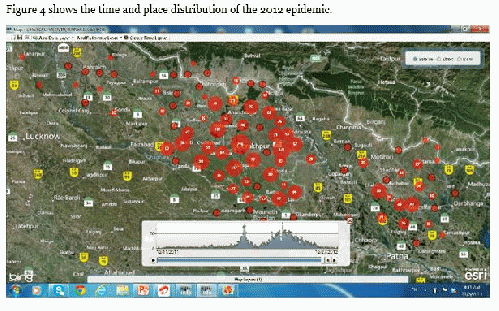
Time and place distribution of 2012 encephalitis epidemic
(Image by CNS (Citizen News Service)) Details DMCA
(CNS): Indian government along with other governments of UN member countries had adopted the Sustainable Development Goals (SDGs) at the 70th UN General Assembly in New York in September 2015. One of the SDG targets (3.3) promises that "By 2030, end the epidemics of AIDS, tuberculosis, malaria and neglected tropical diseases (NTDs) and combat hepatitis, water-borne diseases and other communicable diseases." Encephalitis, one of the NTDs, continues to severely impact under-15 year old people with very little well-coordinated response to contain, and eventually eliminate it. Why?
Seasonal, pre- and post-monsoon, encephalitis epidemics in under-15 years old have ravaged India for more than 35 years. Killing 1000 under 15-year olds between UP, Bihar and Assam alone, disabling 3000, causing acute sickness in 5000 and if it is predominantly waterborne then carried by 5,000,000 per year is the story up to now. Both in terms of research, strategic planning, policy and implementation the response has been insufficient and fragmented.
Is response disproportionately weak to the epidemic?
Numbers refuse to relent and slowly we, the politicians, the bureaucrats, the technocrats and the media are becoming habituated, accepting it as the fate of the poor and making this fait accompli a necessary part of their lives. At all places the paralysis is similar. When we know it is coming we, a small number responsible for fighting it "David's equipped with stone slinging Gulels (sling)" face the Goliath with brave statements like "this time we will do the best ever". Some may even fudge and confuse data to prove to their point and some heavy weights loudly air their opinions even without data on the basis of their unpublished experience.
In a typical fire-fighting mode there is a flirt of uncoordinated, fragmented confused activity in small bureaucratic and technocratic groups in affected states and then, after the ravage, the customary thanks that it is over and now is the time to sleep and we will certainly do something better next year. Sometimes somebody for example the National Commission for Protection of Child Rights in 2012 lambasted the Uttar Pradesh government for its 'casual' response to the rising death toll from Japanese Encephalitis (JE) and acute encephalitis (AES) in the eastern districts of the state but the blast falls on deaf ears, on a Government famous for its plurality, for the blame is shared by everyone, nobody is held accountable and 37 years have passed in this insufficient uncoordinated action.
Where is science in this?
Where are the age old established methods of Epidemiology to study the distribution and determinants of disease? The answer is, in the back seat, unsung and considered unimportant by the decision makers. That is the reason of the response falling apart and being ineffective. No thinking before acting.
In preventing the disease the vector borne Japanese Encephalitis positive in less than 5%, the waterborne other unidentified biological infective agent probably accounting for the rest and theories of toxicity by Litchi chinensis selling pre-monsoon in Himalayan foot hills, or heat and humidity theories have to be considered, prevention strategies developed and thus the preventable suspect etiology prevented. Till the exact agent, host and environment factors are identified by credible research a shot gun approach has to be strategized to decrease the occurrence of the disease.
(Note: You can view every article as one long page if you sign up as an Advocate Member, or higher).





